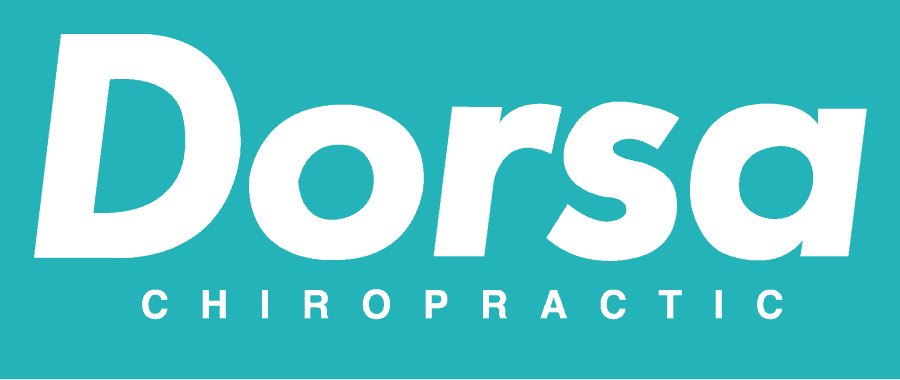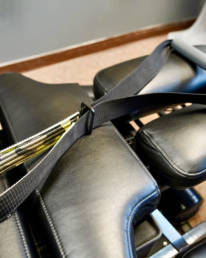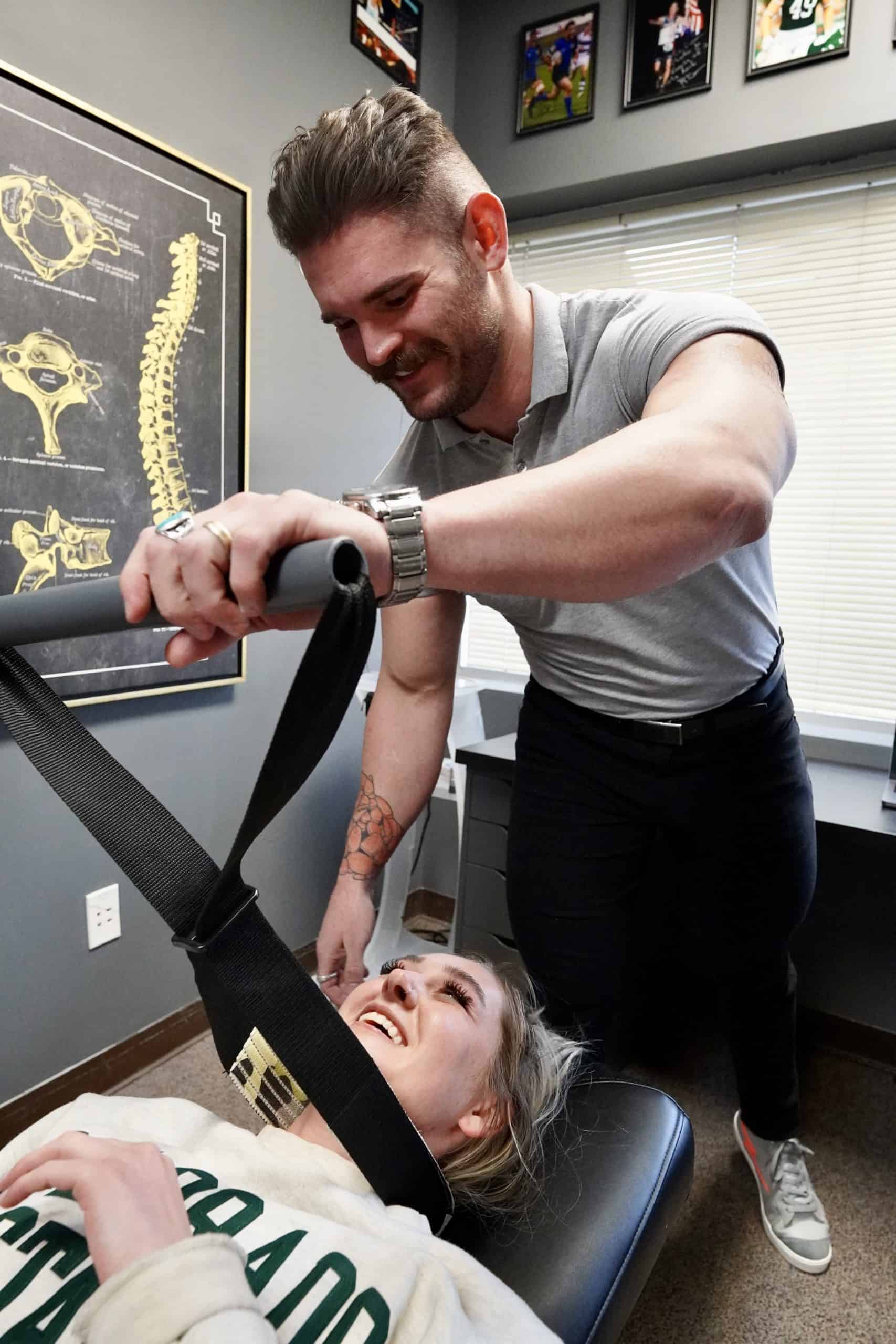Compression equals pain. It’s so easy for the neck and spine to become compressed as we face what can feel like the “pressures of the world” on our shoulders. Here at Dorsa Chiropractic in Denver Colorado, we see patients struggling with painful, restrictive compression issues find relief every single day through innovative decompression therapies designed for our hectic, screen-based lives that can wreak havoc on our spinal alignment. The rise of screen-based living has greatly increased the number of patients seeking help for neck and spinal compression. One of the biggest causes of compression is something called forward head posture.
It’s so easy to fall into a habit of using forward head posture as our default posture. The transition to working and learning from home created an epidemic of neck and spinal issues. It’s very easy to make our necks “stoop” when we’re looking at screens. This can happen when we’re sitting at a desk, lounging on a couch, or standing up while reading text on a screen. What’s more, the rise of makeshift “dining room table” desks means that many people are looking at screens that aren’t positioned at the proper height for good posture. This means that people are looking down at their screens instead of using proper posture that aligns the eyes, chin, and shoulders. Constant slumping for long periods of time while focusing on work or entertainment is one of the biggest factors behind painful compression issues. Of course, this isn’t the only cause.
Neck and spinal compression can happen to any person of any age. The weight of the head and shoulders can simply make it difficult to stand up straight with proper alignment when we don’t have the right tools to know how to maintain good posture. An improper form that’s kept when performing repetitive work duties, workouts, tasks around the home, or sports-related movements can all set us up for compression.
Many patients come to Dr. Dorsa seeking pain relief, restoring flexibility, and improved range of motion without realizing that compression is the underlying cause of their issues. This is precisely why the techniques and exercises they’ve tried at home aren’t working. What’s more, even many of the classic chiropractic adjustments used to restore spinal alignment won’t be effective immediately if the compression is severe enough. This is where Y-strap adjustments come into the picture. This is such an important treatment to know about if you’re experiencing classic telltale signs of compression that can include:
- Pain in the neck or back.
- Stiffness in the neck or back.
- A painful burning sensation extending throughout the arms, buttocks, and legs.
- Numbness or weakness in the arms, hands, and legs.
- Cramping in the arms, hands, and legs.
- Loss of sensation.
- Troubling coordinating limbs.
- Limp feet.
In some cases, extreme pressure on the lumbar region can actually lead to serious symptoms like loss of bowel control, loss of bladder control, and sexual dysfunction. Some people experience degrees of weakness and numbness that make it difficult to stand up. Ruling out a more serious medical condition is always important when dealing with a suspected case of spinal compression. Next, it may be time to speak with Dr. Dorsa about how Y-strap adjustments can help you to reverse decompression.
How Do Y-Strap Adjustments Help With Decompression?
A Y-strap adjustment is effective at reversing decompression because it stretches the spine using momentum from the Y-axis of the body. The pulling force that is created manually by the chiropractor using the Y-strap instrument generates enough force to decompress the vertebral discs. During the process, the chiropractor is able to manually apply different force speeds and patterns to create the desired result based on the location and severity of a patient’s compression. In addition to eliminating compression, this therapy can also be essential for allowing nutrients and blood to flow back to the discs. Here’s a step-by-step look at this gentle procedure in action:
- Dr. Dorsa places the bottom of the Y-strap securely around the back of the patient’s head near the base of the skull.
- Next, the strap on the Y-strap is carefully cinched at the middle to create the signature “Y” shape.
- Dr. Dorsa uses the handgrip on the device to position the strap at an “elevated and away” angle from the patient’s body.
- Dr. Dorsa delicately pulls the strap away from the patient’s body to swiftly decompress the spine.
The approach used when operating the Y-strap can be adjusted for each patient’s needs. When you visit Dorsa Chiropractic, Dr. Dorsa will conduct a complete evaluation before designing a treatment plan for you. Most patients will require a simple technique that decompresses the vertebrae with a single movement. However, it can be beneficial in some cases to use gentle side-to-side motions to “wake up” the spine. It’s important to make sure that blood flow is restored to the compressed area because compression can starve the vertebra of nutrients.
Are Y-Strap Adjustments New?
Y-strap adjustments have actually been used for more than 100 years to manually relieve spinal compression. We also know from studies that high-velocity low amplitude (HVLA) cervical manipulation techniques that can include Y-strap therapy have been shown to have extremely positive impacts on pain, mobility, and strength. Y-strap therapy is also considered a safe, non-invasive treatment that is appropriate for a wide variety of people.
Learn More About Y-Strap Compression Near Denver Colorado
As an experienced sports chiropractor, Dr. Dorsa has seen the way that Y-strap therapy helps people to naturally overcome compression and lumbar pain without the need for pain medication or surgery. Continuing to go about your daily life, work duties, and workout plans with a compression issue can result in severe strain and injury. The first step to getting relief is determining if your pain, discomfort, stiffness, loss of flexibility, or movement issues are caused by an undiagnosed compression vertebral compression. Book an appointment with Dr. Dorsa at Dorsa Chiropractic in Denver to learn more about innovative Y-strap adjustments.

Welcome to Dorsa Chiropractic. We started this practice to help people like you feel great!
When you visit us here at Dorsa Chiropractic, we’ll go over your injury, pain points, or general wellness goals. Our doctors will conduct an assessment to verify the root of your physical symptoms to come up with a plan for bringing your body back to health.


